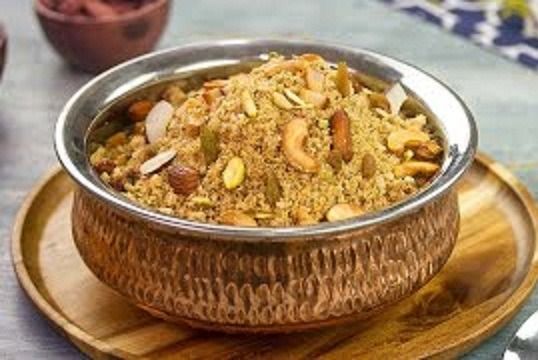Description
History and Cultural Significance
Panjiri has its roots deeply embedded in the culinary traditions of Punjab and other parts of North India. It has been prepared for centuries as a part of celebratory occasions, especially for mothers after childbirth, to help them regain strength and vitality. Historically, it was also consumed during the winter months due to its warming properties, and it was often offered to women after delivery as a postpartum dietary supplement.
The dish is known to be a powerhouse of nutrients that aids in healing, energy restoration, and boosting the immune system. The ingredients used in panjiri, such as ghee, dry fruits, and jaggery, are rich in essential fatty acids, proteins, vitamins, and minerals, all of which help in recovering from the physical toll of childbirth. It is believed that the ghee and dry fruits used in panjiri not only nourish the body but also increase the production of breast milk in nursing mothers.
Over time, the popularity of panjiri spread beyond just its use during postpartum care. It became a common winter snack, especially in Punjabi and Rajasthani households, and has now found its way into various regional cuisines across India. The versatility of panjiri allows it to be adapted with different ingredients based on taste preferences or regional variations, but its basic essence remains the same—a nutrient-dense food that provides warmth, energy, and sustenance.
Health Benefits
Panjiri is packed with a wide array of health benefits, which is why it is highly recommended during pre and post-delivery periods. Its key ingredients work synergistically to provide:
- Energy Boost: The combination of ghee and dry fruits like almonds, cashews, and pistachios gives an instant energy boost, making it an ideal food for women recovering from childbirth, as well as anyone in need of a quick energy lift.
- Rich in Nutrients: Panjiri is a great source of proteins, healthy fats, vitamins, and minerals, which are essential for the body’s recovery, especially after childbirth.
- Improved Lactation: Ingredients like fennel seeds (saunf) and gond (edible gum) are traditionally known to enhance milk production in new mothers.
- Improved Digestion: Spices like ginger, cardamom, and fennel promote digestion and help in balancing the body’s internal systems after childbirth.
- Immune System Support: Dry fruits, nuts, and herbs used in panjiri are packed with antioxidants, which help strengthen the immune system.
- Hormonal Balance: The combination of ghee and other medicinal herbs helps in balancing hormones and nurturing the body’s recovery processes after pregnancy.
Traditional Ingredients
The ingredients for panjiri may vary slightly based on regional preferences, but the core ingredients generally include:
- Whole Wheat Flour (atta): This forms the base of the dish and is a rich source of complex carbohydrates, which provide lasting energy.
- Ghee: A key component that adds richness and flavor, ghee also helps in better absorption of the fat-soluble vitamins and provides a host of health benefits.
- Dry Fruits and Nuts: Almonds, cashews, walnuts, pistachios, and raisins add a burst of nutrients, flavor, and texture. These nuts are high in essential fats, proteins, and antioxidants.
- Jaggery (gur): A natural sweetener, jaggery is often used in panjiri instead of refined sugar due to its higher nutrient content, including iron and minerals.
- Spices: Ground cardamom, ginger powder, and fennel seeds not only enhance flavor but also aid in digestion and provide a warm, soothing effect on the body.
- Edible Gum (Gond): This ingredient is typically used for its healing properties, promoting joint and bone health, and boosting energy levels.
Panjiri Recipe
Here’s a simple and traditional recipe to make panjiri at home:
Ingredients:
- 1 cup whole wheat flour (atta)
- ½ cup ghee (clarified butter)
- 1/2 cup almonds, chopped
- ¼ cup cashews, chopped
- ¼ cup walnuts, chopped
- ¼ cup pistachios, chopped
- ¼ cup raisins
- 2 tablespoons fennel seeds (saunf)
- 1 tablespoon ginger powder (or fresh ginger, finely grated)
- 1 teaspoon cardamom powder
- 1 tablespoon edible gum (gond)
- 1 cup jaggery, grated (or adjust to taste)
- 1 tablespoon poppy seeds (optional)
- 1 tablespoon melon seeds (optional)
Instructions:
- Prepare the Edible Gum:
- Heat a small pan on low heat and add the edible gum. Fry it in ghee until it puffs up and turns golden. Once puffed, remove from the pan and set aside.
- Roast the Nuts and Dry Fruits:
- In the same pan, dry roast the almonds, cashews, walnuts, and pistachios until they become slightly golden and aromatic. Set aside.
- In the same pan, lightly roast the fennel seeds, cardamom, and ginger powder for a few seconds, just until fragrant. Set them aside as well.
- Make the Base:
- In a large pan, heat the ghee on medium-low heat. Once the ghee is melted, add the whole wheat flour (atta).
- Roast the flour in ghee, stirring constantly, until it turns a light golden brown and gives off a nutty aroma. This process may take around 10-12 minutes, so be patient and keep stirring to prevent burning.
- Combine Ingredients:
- Once the flour is roasted, add the roasted nuts, dry fruits, and spices to the pan. Mix everything thoroughly.
- Now, add the puffed edible gum (gond) and mix again.
- Sweeten the Panjiri:
- Lower the heat and add the grated jaggery to the mixture. Stir continuously to allow the jaggery to melt and mix evenly into the ingredients. This should take about 3-4 minutes. If you prefer a smoother consistency, you can add a small amount of milk or water, but this is optional.
- Cool and Store:
- Once the jaggery has melted and the mixture is well combined, remove from heat.
- Let the panjiri cool to room temperature. As it cools, the mixture will firm up and become more granular in texture.
- Store the cooled panjiri in an airtight container. It can be consumed as a nutritious snack or energy booster, especially for new mothers or anyone in need of a healthy, nutrient-dense food.
Serving Suggestions:
Panjiri can be eaten on its own, sprinkled on top of milk or yogurt, or even served as a sweet snack with tea. It can be stored for up to a couple of weeks, making it an ideal treat to have on hand during the winter months or as a postpartum recovery aid.
Final Thoughts
Panjiri is more than just a snack; it’s a traditional health food that packs a punch in terms of nutrition, flavor, and energy. The wholesome ingredients make it a natural remedy for postpartum recovery, offering a balance of proteins, fats, and carbohydrates. Whether you’re preparing it for a new mother or simply looking for a warm, energy-boosting treat, panjiri is sure to nourish the body and satisfy your taste buds.


Reviews
There are no reviews yet.